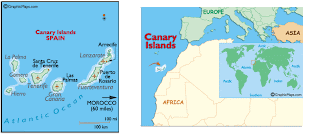 |
| Equestre |
The trouble begins with this beauty. Linneaus named it Amaryllis Equestre ("Knight's or Horseman's Star") It came from Surinam--2 to 5 degrees from the Equator on the coast of S. America, next to Brazil . Surinam is very tropical , has 2 wet seasons and 2 dry*.
This tropical "amaryllis" caused the next round of botanists no end of trouble, as it turned out Equestre was not inter-fertile with the S.African bulb, already named amaryllis. Equestre was a different genus with different blooming habits.
 |
| Surinam c 1840 |
Hands were wrung, decisions were made as tactfully as possible by one of our heroes
Dean of Manchester, the Hon. and Rev. William Herbert the final authority on amaryllis.(see earlier blog). He decided to create a separate genus name for the S. American bulbs, which besides being tropical, had a differently shaped bloom than the A. belladonna lily from S. Africa, and quite different growing habits.
 |
| Amaryllis Belladonna |
However, they've been hybridized to bloom in December, if watered. (Since the 2 wet seasons they started out being used to, are the hybridizer's delight.) These are the ones that can be depended on to bloom in their individual pots at Christmas time. Happy Hippeastrum!
Once had an ambition to have enough amaryllis and hippeastrum growing to use them as cut flowers.....then realized this was probably a form of horticultural hubris that would result in every snail in So Cal descending on the garden and eating the leaves of both Amaryllis and Hippeastrum as they emerged from the ground.
****************** *************************
 |
| Macedonian coin showing the horseman's star Centaurus |
c. 320 B.C.
*See p 138 of Herbert (1837) Amaryllidaceae . Linneus named his bulb Equestre. Lat. gen.-- refers to The Horseman constellation.That's why politic Herbert kept the idea going in Hippeastrum. (Horseman's Star).
When the Horseman rises the spring rains are coming, and this observation goes back to the Sumerians. That's when the Hippeastrum bloom along the Coast here, if planted in the garden..














































